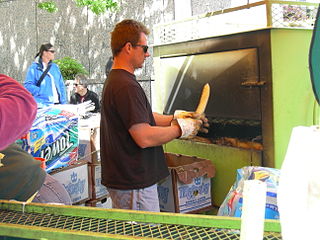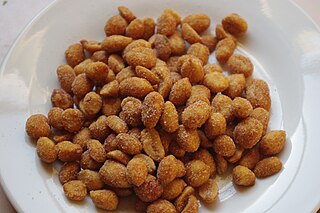
The peanut, also known as the groundnut, goober (US), pindar (US) or monkey nut (UK), is a legume crop grown mainly for its edible seeds. It is widely grown in the tropics and subtropics, important to both small and large commercial producers. It is classified as both a grain legume and, due to its high oil content, an oil crop. World annual production of shelled peanuts was 44 million tonnes in 2016, led by China with 38% of the world total. Atypically among legume crop plants, peanut pods develop underground (geocarpy) rather than above ground. With this characteristic in mind, the botanist Carl Linnaeus gave peanuts the specific epithet hypogaea, which means "under the earth".

Cracker Jack is an American brand of snack food that consists of molasses-flavored, caramel-coated popcorn, and peanuts, well known for being packaged with a prize of trivial value inside. The Cracker Jack name and slogan, "The More You Eat The More You Want", were registered in 1896. Some food historians consider it the first junk food.

Popcorn is a variety of corn kernel which expands and puffs up when heated; the same names also refer to the foodstuff produced by the expansion.

Peanut butter is a food paste or spread made from ground, dry-roasted peanuts. It commonly contains additional ingredients that modify the taste or texture, such as salt, sweeteners, or emulsifiers. Consumed in many countries, it is the most commonly used of the nut butters, a group that also includes cashew butter and almond butter.

Planters Nut & Chocolate Company is an American snack food company now owned by Hormel Foods. Planters is best known for its processed nuts and for the Mr. Peanut icon that symbolizes them. Mr. Peanut was created by grade schooler Antonio Gentile for a 1916 contest to design the company's brand icon. The design was modified by a commercial artist and has continued to change over the years.

Boiled peanuts are popular in some places where peanuts are common. Fully mature peanuts do not make good quality boiled peanuts; rather, raw or green ones are used. Raw denotes peanuts in a semi-mature state, having achieved full size but not being fully dried, as would be needed for roasting or peanut butter use. Green denotes freshly harvested and undried peanuts that must be refrigerated. After boiling in salt water they take on a strong salty taste, becoming softer with prolonged cooking, and somewhat resembling a pea or bean, to which they are related because they are legumes and a nut only in the culinary sense.

Peanut oil, also known as groundnut oil or arachis oil, is a vegetable oil derived from peanuts. The oil usually has a mild or neutral flavor but, if made with roasted peanuts, has a stronger peanut flavor and aroma. It is often used in American, Chinese, Indian, African and Southeast Asian cuisine, both for general cooking and in the case of roasted oil, for added flavor. Peanut oil has a high smoke point relative to many other cooking oils, so it is commonly used for frying foods.

Corn on the cob is a culinary term for a cooked ear of sweet corn (maize) eaten directly off the cob. The ear is picked while the endosperm is in the "milk stage" so that the kernels are still tender. Ears of corn are steamed, boiled, or grilled usually without their green husks, or roasted with them. The husk leaves are removed before serving.

Home roasting is the process of roasting coffee from green coffee beans on a small scale for personal consumption. Home roasting of coffee has been practiced for centuries, using simple methods such as roasting in cast iron skillets over a wood fire and hand-turning small steel drums on a kitchen stovetop.
Amedeo Obici was an Italian-born American businessman and philanthropist who founded Planters.
Matthew Algie is an independent coffee roaster with registered offices at 16 Lawmoor Road, Glasgow, United Kingdom. The company sells its coffee to coffee shops, bars, restaurants, hotels and businesses across the UK & Ireland and also offers coffee machines for hire - supported by a network of field engineers as well as a range of coffee-related equipment and complementary products through its sister-company Espresso Warehouse. Additionally, Matthew Algie also provide SCA accredited barista training courses, taught via their training campuses based in London, Glasgow & Dublin.

Roasting coffee transforms the chemical and physical properties of green coffee beans into roasted coffee products. The roasting process is what produces the characteristic flavor of coffee by causing the green coffee beans to change in taste. Unroasted beans contain similar if not higher levels of acids, protein, sugars, and caffeine as those that have been roasted, but lack the taste of roasted coffee beans due to the Maillard and other chemical reactions that occur during roasting.

Ghanaian cuisines refer to the meals of the Ghanaian people. The main dishes of Ghana are organized around starchy staple foods, accompanied by either sauce or soup as well as a source of protein. The main ingredients for the vast majority of soups and stews are tomatoes, hot peppers, and onions. Most Ghanaian soups and stews are red or orange in appearance as a result of the main ingredients used.

A popcorn maker is a machine used to pop popcorn. Since ancient times, popcorn has been a popular snack food, produced through the explosive expansion of kernels of heated corn (maize). Commercial large-scale popcorn machines were invented by Charles Cretors in the late 19th century. Many types of small-scale home methods for popping corn also exist.
Koh-Kae is a Thai brand of nut snacks manufacturing by Mae-Ruay Snack Food Factory Co., Ltd. And was first sold in 1976. In its early day Koh-Kae only came in their original flavor, which is coconut cream coated peanuts, but they developed others flavor such as tom-yum and chicken flavor later on. By 2000, Mae-Ruay Snack Food Factory Co., Ltd. was awarded ISO 9001 certification by BVQI Institute, followed by the GMP and HACCP system certification by BVQI in 2002. In year 2019 Koh-Kae holds 50% of Thailand nut snacks market share.
The Weaver Popcorn Company, based in Van Buren, Indiana, is one of the largest popcorn companies in the United States.

A corn roaster is a large grill for cooking large batches of ears of corn at the same time. The term "corn roaster" can also refer to a person who roasts corn. Corn roaster machines have existed in the United States since at least 1900. Corn roasters are used by concession vendors at festivals, fairs, events, parties, and holidays, such as the Fourth of July in the United States. Roasted corn is a very popular festival food in the American South, Southwest, and Northwest. Corn roasters can also cook foods such as turkey legs, potatoes, and sweet potatoes. They may also be used by street food vendors. Street vendors may operate seasonally, per the seasonality of corn crops. Some organizations that operate corn roasters at events, such as fairs, donate their proceeds to charities.

Shearer's Foods, LLC is a U.S. manufacturer and distributor of snack foods. Founded in 1974 as Shearer's Snacks, it is headquartered in Brewster, Ohio.
Metal Ware Corporation is a company located in Two Rivers, Wisconsin and manufactures small kitchen appliances primarily marketing them under the NESCO and American Harvest brand names.

Honey-roasted peanuts is a salt-, sugar- and honey-flavored peanut snack food that is provided as a mass-produced product line by several nut and snack food companies, such as Planters, The Sun Valley Nut Co, and King Nut.
















